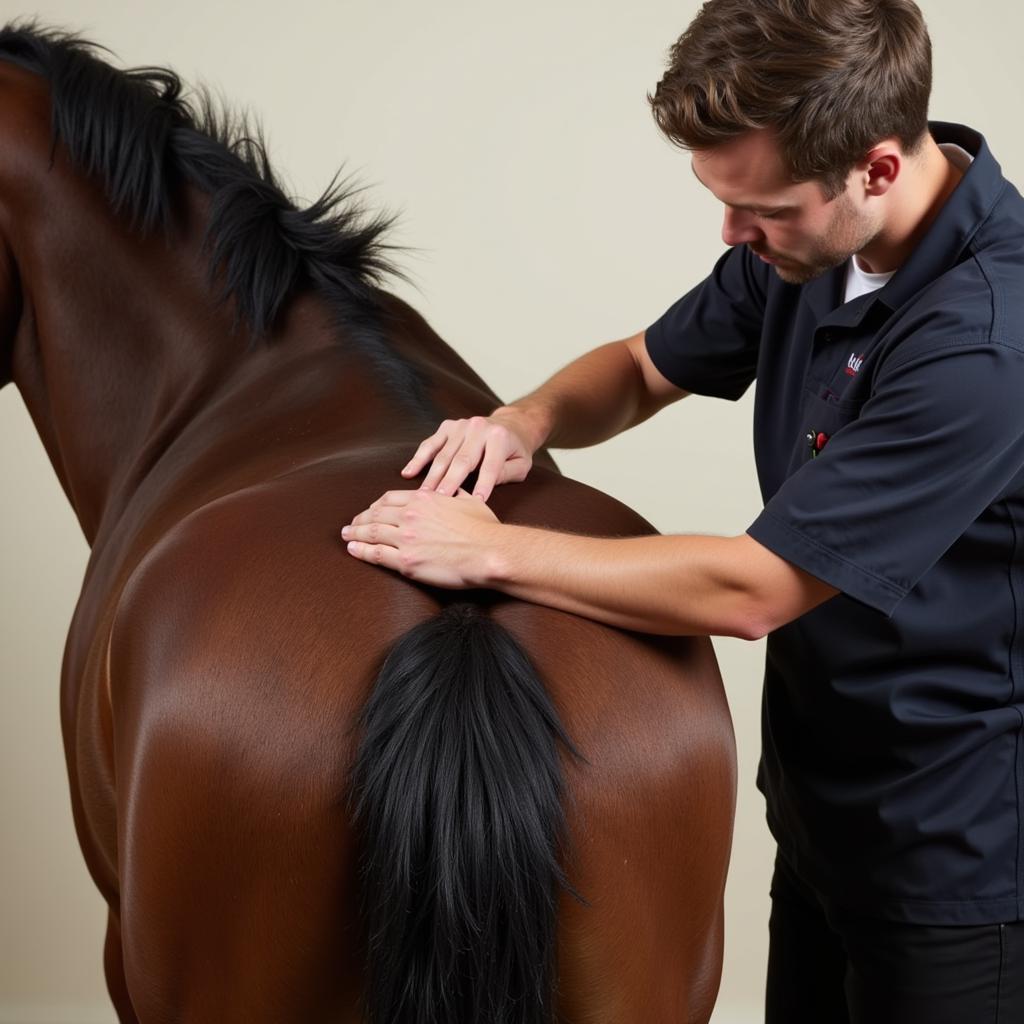Scoliosis in horses, a lateral curvature of the spine, can be a concerning condition for horse owners. This article will delve into the complexities of equine scoliosis, covering its causes, diagnosis, treatment options, and management strategies.
What is Equine Scoliosis?
Equine scoliosis involves an abnormal sideways curvature of the vertebral column, often accompanied by a rotational deformity. This can lead to unevenness in the horse’s back, potentially affecting their movement, performance, and overall well-being. Understanding this condition is crucial for early diagnosis and effective management.
Causes of Scoliosis in Horses
The exact causes of scoliosis in horses aren’t always clear. Several factors are suspected, including:
- Congenital Defects: Some horses are born with scoliosis due to developmental abnormalities in the spine.
- Trauma: Injuries to the spine, such as fractures or dislocations, can sometimes lead to scoliosis.
- Uneven Muscle Development: Asymmetrical muscle development, potentially due to training imbalances or conformation flaws, may contribute to the development of scoliosis.
- Nutritional Deficiencies: While less common, inadequate nutrition during growth can potentially impact spinal development.
Diagnosing Scoliosis in Horses
Diagnosing scoliosis typically involves a thorough physical examination by a veterinarian. The vet will assess the horse’s posture, back symmetry, and range of motion. Diagnostic imaging, such as X-rays, is essential for confirming the diagnosis and determining the severity of the curvature.
Signs and Symptoms of Scoliosis
Recognizing the signs of scoliosis can be crucial for early intervention. Some common indicators include:
- Uneven back musculature
- Asymmetry in the rib cage
- Difficulty tracking straight
- Reduced performance
- Back pain or stiffness
Treatment and Management of Horse with Scoliosis
Unfortunately, there’s no cure for scoliosis in horses. However, various management strategies can help minimize its impact and improve the horse’s quality of life. These include:
- Chiropractic Care: Regular chiropractic adjustments can help maintain spinal alignment and reduce pain.
- Physiotherapy: Targeted exercises and stretches can improve muscle strength and flexibility, supporting the spine.
- Pain Management: Medications, such as non-steroidal anti-inflammatory drugs (NSAIDs), can help manage pain and inflammation.
- Corrective Shoeing: Specialized farriery can help balance the horse’s stance and reduce stress on the spine.
“Early diagnosis and intervention are key to managing scoliosis effectively,” says Dr. Emily Carter, DVM, an equine sports medicine specialist. “While we can’t reverse the curvature, we can implement strategies to minimize its impact and improve the horse’s comfort and functionality.”
Living with a Horse with Scoliosis
Managing a Horse With Scoliosis requires a long-term commitment. Regular monitoring by a veterinarian and a tailored management plan are crucial for maintaining the horse’s well-being.
 Horse undergoing chiropractic treatment for scoliosis.
Horse undergoing chiropractic treatment for scoliosis.
“It’s important to remember that every horse with scoliosis is unique,” adds Dr. Carter. “The management approach should be tailored to the individual horse’s needs and the severity of their condition.”
Conclusion
Scoliosis in horses presents unique challenges, but with proper diagnosis and management, affected horses can often lead fulfilling lives. Understanding the condition and working closely with a veterinarian are essential for ensuring the best possible outcome for a horse with scoliosis.
FAQ
- Can a horse with scoliosis be ridden? It depends on the severity of the curvature. Some horses with mild scoliosis can be ridden with appropriate management, while others may not be suitable for riding.
- Is scoliosis painful for horses? Scoliosis can cause pain and discomfort, especially as the horse ages.
- How is scoliosis diagnosed in foals? Scoliosis in foals can be diagnosed through physical examination and X-rays.
- Can scoliosis be prevented in horses? While some cases of scoliosis are congenital and cannot be prevented, ensuring proper nutrition and avoiding trauma can help minimize the risk.
- What is the prognosis for a horse with scoliosis? The prognosis varies depending on the severity of the curvature and the horse’s individual response to treatment.
If you need assistance, contact us at Phone Number: 0772127271, Email: [email protected] Or visit us at: QGM2+WX2, Vị Trung, Vị Thuỷ, Hậu Giang, Vietnam. We have a 24/7 customer service team.